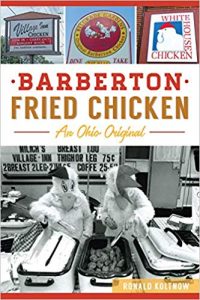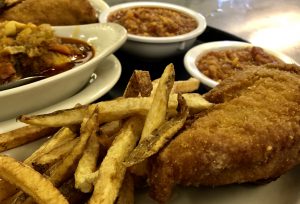Ron Koltnow appreciates the finer things in life, notably good food – and cats! I knew Ron as a book person – and a book rep – long before I was aware that he was also writer. Now that he’s come out, so to speak, I am thrilled to help spread the word about Barberton Fried Chicken: An Ohio Original, which not only explains a regional delicacy, it explores its roots in immigration and industrialization of an overlooked part of the country. The result? a finger-licking good read…

How does a book start for you?
This is a daunting question for a novice writer. The ideas come to me while I am reading or watching something on television. Many years ago, a law school friend sent me an article that I thought would form the basis of my first novel. Forty years later, and after some preliminary research, the book remains unwritten. Time and tastes are not constant. I fear that the book could not be written in today’s climate. Once, I spotted a documentary on Yahoo News, a 20-minute piece on J. Edgar Hoover. I have been researching the Director ever since, and the book inspired by that video is in the outline stage. The book Barberton Fried Chicken: An Ohio Original came about in the most serendipitous of ways. I had always wanted to write a food book, especially one on the food of my youth. One day an ad appeared on Facebook. The History Press has an imprint called American Palate, dedicated to the history of regional foods. The ad was a call for books on regional food specialties. Within a matter of hours, the editor and I had agreed that the Serbian fried chicken of Barberton, Ohio deserved to have its history told.

Who in your latest book has surprised you most — and why?
The answer is a where, not a who. Barberton is a working class, highly ethnic, moribund industrial city a few miles to the southwest of my native Akron, Ohio. As had happened in may industrial cities, immigrants came from all over Europe to find jobs in the factories. There was a heavy Eastern European immigrant wave, among which were my grandparents. By the time I left Ohio in 1982, Barberton, once called the Magic City, was all but dead. As I read the history of the place, a planned community built by Ohio’s Match King O. C. Barber, the more fascinating the area became. It was an area inhabited first by the Lenape people, by European farmers, by early industries, and ultimately as Barber’s vision of the City of the Future. Barber was a Robber Baron, and, I always assumed, shady. He turned out to be a visionary, spearheading industry and farming in revolutionary ways. His was the first factory with a hospital, a workers’ restaurant, and some medical benefits. Barber had his hands in everything from landscaping to hospital building. He was a true hero.
When and/or where is your latest book set and is there a story behind the setting?
Barberton brought workers from all over the worlds. The largest immigrant groups were the Eastern Europeans (Hungarians and Czechs especially), Italians, and Germans. The first flag immigrants plant in their new cities is their native food. The men came to Barberton to work in the factories, while the women cooked. Specialty food shops began springing up in the downtown Barberton area– groceries, drug stores, and restaurants. In 1933, after losing the family farm to foreclosure, a Serbian woman named Smilka Topalsky opened a small restaurant, serving soups and sandwiches to workers. One day, she was cooking her familuy’s dinner, a Serbian recipe for fried chicken, cabbage slaw, and a rice and tomato based hot sauce called djuvece. The patrons of the restaurant wanted to try some of that exotic food. Belgrade Gardens opened in 1933 and is still serving the same food today. Within 20 years, there were five Serbian (and one Czech) fried chicken restaurant, all within a two-mile radius of each other. Four of those restaurants are still there.

What are you working on now?
There is a food myth that the hamburger was first invented by a cook from Akron. It is rumored that he invented the ice-cream cone as well. Should I continue in food writing mode, the next book will be THE HAMBURGER IN AKRON, Volume Two of what I call The Foods of My Youth. There will be a follow-up to the Chicken book, but it will probably be an article. The J. Edgar Hoover novel will occupy most of my time over the next few years. Unfortunately, the history of the witch-hunting 1950s hews too closely to our current political climate. Liberals were suspect if they read the wrong books, women would lose their jobs if they appeared mannish, and men had to be white-shirted and distinctly hetero or their lives were ruined. A moderate senator committed suicide rather than having his gay son exposed by his opponents. Those days were a nightmare, one that is on the verge of reappearing. It should be a pulpy thriller with a lot of action, but it is too serious a theme to be treated flippantly.
Which question[s] didn’t I ask you that I should have?
What did I have to leave out of my brief history that interested you? While reading of immigrant groups who came to Barberton for jobs, I learned about the initial African-American appearance in the area. The first black workers who came to Barberton were hired to be scabs at a nearby mine. When the trainload of men arrived, and they refused to cross the picket line, many stayed and open businesses of their own. The first black-owned business in the area was a barber shop that existed in the area called Snydertown for years. As my book tries to correct the assumption that fried chicken is purely a southern dish, I had to leave this part of the history out.
What was your biggest challenge?
This is a history not a memoir. Narrative non-fiction is best told without a first-person presence. It was tempting to tell a story as a memory, but the dictates of the form left me out of the story. I do get a personal history in the final section of the book.
What was the drawback to writing about fried chicken?
My wife made me go to the cardiologist after doing the research (most of which involved eating). The heart was fine, but the waistline needs fine tuning.
Ron Koltnow was a sales and marketing representative for Penguin Random House. He was Publishers’ Weekly‘s Rep of the Year in 2010. He has been a teacher, a bookseller, and a business writer for Blue Cross and Blue Shield. His articles have appeared in Washington, D. C.’s City Paper, the ARSC Journal, Magill’s Survey of Foreign Language Films, and Magill’s Cinema Annual. Barberton Fried Chicken is his first book. He lives in Boston with a wife and two beloved cats.
